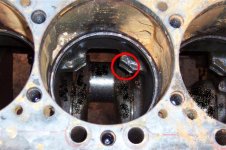AlanB
Elite Member
Eddie, once again, I must say, "You are the Man"
I consider myself a fair mechanic, but you jump in both feet and make it happen. My hat is off to you, looks like you are doing a great job, and I would also fully agree, that once I was in that far, I would want to only do it once and be done with it. I have to believe that what you are saving in labor more then makes up for the additional cost in parts.
Anyway, as to freezing things, when a main rotor head gets stuck on a mast (similar to what you are dealing with) we will build a little dam down inside the mast (hollow tube on an apache) and then fill it with dry ice and it will contract enough to make the head bearings come loose.
I think you could do much the same thing with your new liners.
I did love the thought of returning the freezer to Lowes though /forums/images/graemlins/grin.gif But even more so I can see you walking in with the sleeve, and Test fitting all the freezers /forums/images/graemlins/grin.gif
I consider myself a fair mechanic, but you jump in both feet and make it happen. My hat is off to you, looks like you are doing a great job, and I would also fully agree, that once I was in that far, I would want to only do it once and be done with it. I have to believe that what you are saving in labor more then makes up for the additional cost in parts.
Anyway, as to freezing things, when a main rotor head gets stuck on a mast (similar to what you are dealing with) we will build a little dam down inside the mast (hollow tube on an apache) and then fill it with dry ice and it will contract enough to make the head bearings come loose.
I think you could do much the same thing with your new liners.
I did love the thought of returning the freezer to Lowes though /forums/images/graemlins/grin.gif But even more so I can see you walking in with the sleeve, and Test fitting all the freezers /forums/images/graemlins/grin.gif

